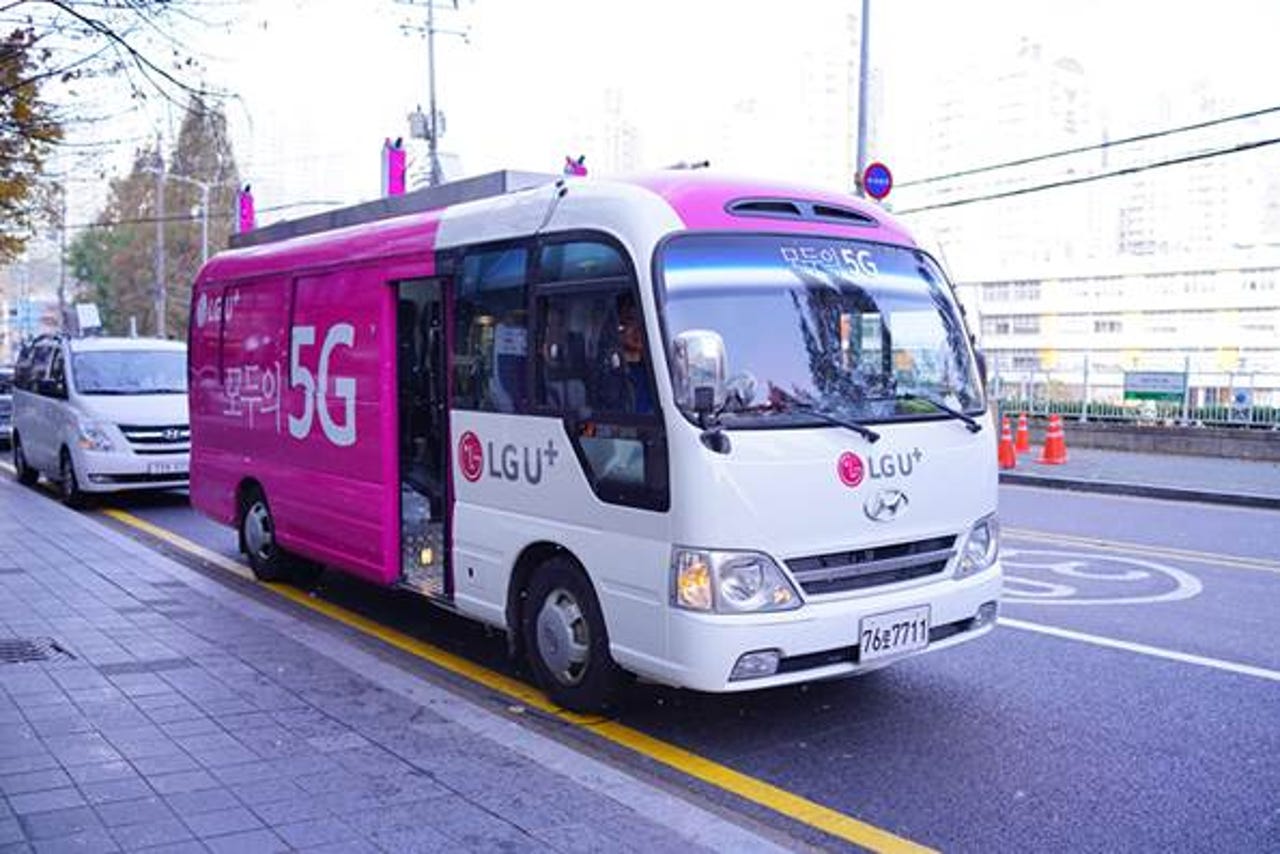Huawei and LG U+ use VR drone to deliver 5G


The 5G 'tour bus'
Huawei and LG U+ have announced finishing 5G field trials in Gangnam District, Seoul, to verify technologies including IPTV 4K video, dual connectivity, and inter-cell handover.
Calling it the world's first widescale 5G network test using a pre-commercial testing environment, the companies used a 5G "tour bus" to deliver 5G 4K IPTV; and used a virtual reality (VR) drone to demonstrate data rates of between 20Mbps and 100Mbps at the LG U+ headquarters.
Huawei also combined 5G customer premises equipment (CPE) with the VR drone to demonstrate throughput of 1.5Gbps from 100m in altitude using the 3.5GHz spectrum band.
"In the Gangnam District of Korea, we have successfully validated the 5G pre-commercial network and released the world's first 3.5GHz CPE," Zhou Yuefeng, CMO of Huawei Wireless Product Line, said.
"This demonstrates that Huawei will maintain its capability to provide competitive E2E 5G network products in 2018. LG U+ and Huawei will continue to conduct further research into 5G technologies and build a robust E2E industry ecosystem to achieve business success in the upcoming 5G era."
Huawei used both 3.5GHz and 28GHz base stations during the trials, attaining average speeds of 1Gbps on the low band and 5Gbps using dual connectivity across both the high and low bands.
"The 5G pre-commercial test based on Huawei E2E 5G devices was implemented in a continuous ring topology. A peak data rate of 20Gbps and an average data rate of more than 5Gbps were achieved through dual connectivity over 3.5GHz and 28GHz," the companies said.
Last month, Huawei and LG U+ had announced completing dual-connectivity technology verification during a 5G trial in Seoul, providing 20Gbps downlink speeds by simultaneously linking two 5G base stations.
The trial took place using a 3.5GHz base station and a 28GHz base station at an LG U+ test base in the Korean capital, with Huawei saying that the dual-connectivity solution can also be used to link 4G and 5G base stations.
"Dual-connectivity is a technique that allows multiple base stations to transmit data simultaneously or alternately to a user so that they can seamlessly communicate with other users when moving between base stations," Huawei said at the time.
LG U+ had previously tested the technology in a lab environment between two 4G base stations.
Earlier this month, Huawei additionally demonstrated separate uplink-downlink (UL/DL) decoupling technology across a 5G-LTE network deployment in London as part of its strategic partnership with BT and EE.
The trial network includes 5G New Radio (5G NR) and LTE co-site deployments, separating UL/DL onto different bands. According to Huawei, this improves coverage and capacity across the C-band by using 4G bands to carry 5G uplink data.
"In the 5G era, the available bands for operators will increase, and the coverage of higher bands such as C-band will become a major barrier to deployment. To solve this problem, networks need to make use of multi-band coordination to eliminate higher band coverage bottleneck," Huawei 5G Product Line president Yang Chaobin said.
"5G UL/DL decoupling effectively enlarges C-Band coverage to achieve C-Band and 1.8GHz co-site deployment with the same coverage, reducing the 5G site investment. The joint test result with BT/EE is a good proof of this."
Huawei has been trialling 5G with carriers worldwide, in January attaining speeds of around 35Gbps with Singaporean telcos StarHub and M1.
The StarHub trial was conducted using 2GHz at the e-band -- which sits between the 60GHz and 90GHz frequencies -- using three layers of e-band, as well as 64 Quadrature Amplitude Modulation (QAM).
The M1 lab trial was conducted at M1's main operating centre in Jurong, and made use of mmWave spectrum in the 73GHz e-band as well as 4x4 MIMO; two-component carrier (2CC) uplink carrier aggregation; 3CC tri-band downlink carrier aggregation; and Higher Order Modulation 256 QAM.
Huawei, which plans to help implement 5G networks by 2020, similarly achieved speeds of 35Gbps during a 5G trial with Australian telecommunications provider Optus in November last year, which was likewise conducted over the 73GHz mmWave spectrum band using the Polar Code coding mechanism.
Related Coverage
Eight reasons the Huawei Mate 10 Pro is good for business
The Huawei Mate 10 Pro is now available outside the US and after using one for a few weeks it is clear there is a lot to like for the enterprise user in this newest Huawei smartphone.
How an IoT sensor is helping Australian milk reach China faster
Telstra, Peloris, Chinese quarantine, Sendum, M2M Connectivity, and multiple Australian milk producers are bringing fresh dairy to China within 36 hours, with the companies using IoT sensors for tracking and temperature monitoring.
Huawei demos 5G uplink-downlink decoupling tech
Huawei has showcased its ability to improve 5G coverage, capacity, and user experience by carrying uplink data via 4G LTE bands and downlink data on 5G bands.
Intel has announced its XMM 8000-series 5G NR modem suite, with the first modem to be available commercially in mid-2019, while also saying it has enabled 5G calls over its Gold Ridge 5G modem unveiled at CES 2017.